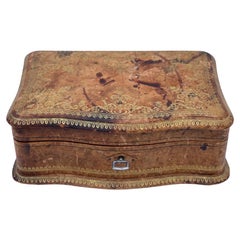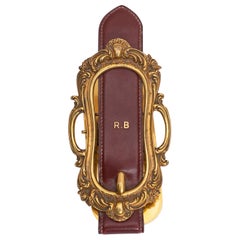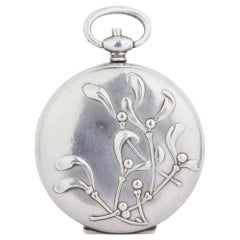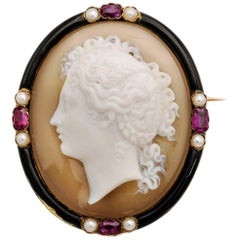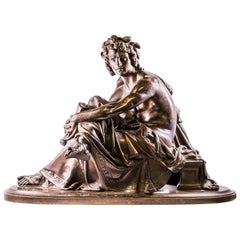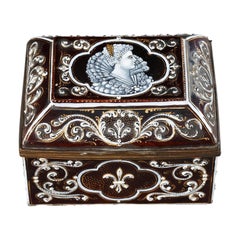French Objets d'Art and Vertu
to
72
196
87
82
57
42
46
19
19
12
12
15
102
227
36
13
5
26
18
9
12
9
14
17
16
12
304
67
9
22
18
16
11
9
to
69
27
14
11
8
92
24
16
15
12
10
8
5
3
3
2
2
1
1
355
25
182
168
Place of Origin: French
Gilded Embossed Antique French Leather Jewelry Box
Located in Chorzów, PL
Beautiful antique leather box for jewels.
Contains removable tray with 2 compartments
Made of leather with gilded embossed decorative pattern
Origin : France, early XX century
Se...
Category
Early 20th Century Art Nouveau French Objets d'Art and Vertu
Hermes Paperweight Leather and Gold Plate Belt Buckle
By Hermès
Located in SAINT-OUEN-SUR-SEINE, FR
Hermes -Paperweight leather and gold plate representing a belt buckle - personal item with a date and initial R.B.
Additional information:
Dimensions: Length: 21.5 cm (8.46"), Widt...
Category
1970s Vintage French Objets d'Art and Vertu
Materials
Gilt Metal
Large French Silver Mistletoe Locket
Located in Brisbane City, QLD
A very fine French silver locket featuring mistletoe to both sides. It has a gold wash interior to prevent tarnish and closes firmly. It appears to be struck with the French guarante...
Category
Early 1900s Art Nouveau Antique French Objets d'Art and Vertu
Materials
Silver
Carved French Maiden Cameo Agate Rubies Pearls 18 Karat Yellow Gold
Located in Berkeley, CA
Four dazzling light pink rubies, eight fresh water pearls, hand carved agate with black enamel. Excellent craftsmanship as this is entirely carved of one piece of agate. Intricate de...
Category
Early 20th Century Napoleon III French Objets d'Art and Vertu
Materials
Agate, Ruby, Pearl, 18k Gold, Yellow Gold
19th Century Albert-Ernest Carrier-Belleuse Bronze Sculpture of Seated Virgil
By Albert-Ernest Carrier-Belleuse
Located in Hicksville, NY
French Second-Empire artist Albert Ernest Carrier-Belleuse is known as the most prolific sculptor of this period. His sculptures were displayed in the Tuileries, the Louvre and the O...
Category
Late 19th Century Napoleon III Antique French Objets d'Art and Vertu
Materials
Bronze
Limoges Enamel Keepsake Box. Second part of the 19th Century.
Located in Paris, FR
Small, rectangular, enamel keepsake box from Limoges. The lid is decorated with a central medallion featuring the profile of an upper-class woman, who was certainly the owner of this...
Category
1870s Renaissance Revival Antique French Objets d'Art and Vertu
Materials
Enamel
HERMES Milo Rodeo MM red leather brown trim fringed tail horse charm
By Hermès
Located in Hong Kong, NT
HERMES Milo Rodeo MM red leather brown trim fringed tail horse charm
Reference: AAWC/A01026
Brand: Hermes
Model: Milo Rodeo MM
Material: Leather
Color: Red, Brown
Pattern: Solid
Clos...
Category
21st Century and Contemporary French Objets d'Art and Vertu
Crystal Flask with Gold, Late 19th Century
Located in Paris, FR
Peardrop-shaped crystal flask in gold mount. The body is finely engraved with an interlaced monogram. The mounting is decorated with an intricate engrave...
Category
1870s Napoleon III Antique French Objets d'Art and Vertu
Materials
Crystal, Gold
Charles X gilt bronze and mother of pearl box with flowers
Located in Paris, FR
Fine rectangular mother of pearl box engraved with garlands of leaves and gilt bronze mounts, finely chiseled with interlacing, garlands and flower basket resting on four winged lion...
Category
1820s Romantic Antique French Objets d'Art and Vertu
Materials
Pearl, Bronze
French, Cigar Shaped Onyx Desk Seal with Diamond Collar & Morocco Leather Case
Located in Brisbane City, QLD
This exquisite desk object was crafted in France during the early 20th Century and would have been an impressive object to own. The desk seal is crafted from a cigar shaped piece of black onyx which features a diamond set collar to one end and a monogram intaglio 'seal' to the other, all circa 1915. The monogram is 'AMF' which has been beautifully engraved into the underside of the seal. The piece retains its original Morocco leather fitted box signed 'Appay', a French manufacturer, and embossed 'AMF' to the top of the lid. The firm Appay were retailing at 24 Rue De La Paix in Paris which is close-by the Place Vendome and also the Opera, however little information is known about the business. The hinge on the Morocco leather box...
Category
Early 20th Century Edwardian French Objets d'Art and Vertu
Materials
Diamond, Onyx
Hermes Palladium Etrier Charm Scarf Ring
By Hermès
Located in Montreal, QC
Hermes Palladium Etrier charm scarf ring new in the box, measures 2cm in diameter x 2.5 cm wide.
Category
21st Century and Contemporary French Objets d'Art and Vertu
Materials
Palladium
New Rare Vintage Pierre Marly Sourcilla Clear Ivory Oversized 1960's Sunglasses
By Pierre Marly
Located in Baleares, Baleares
New and ultra rare " Pierre Marly Sourcilla sunglasses. Spotless rose lenses.
Amazing clear oversized frame. Chic and crazy 1960’s Pierre Marly very own cocktail scene.
A real t...
Category
1960s Vintage French Objets d'Art and Vertu
Cartier Signature Classic Large Double C Yellow Gold Belt Buckle
By Cartier
Located in Southampton, PA
18k Yellow Gold Signature Classic Large Double C Belt Buckle by Cartier.
Details:
Weight: 40.1 grams
Measurements: Buckle: 42mm x 49mm
Fits belt strap ...
Category
1990s French Objets d'Art and Vertu
Materials
Yellow Gold
Antique French Wood Framed "Classical Scene" Miniature, 10.7cm x 10.7cm
Located in MELBOURNE, AU
Antique French Miniature,
wood-framed,
depicting a classical scene painting
Dimensions: 10.7cm x 10.7cm
Category
1850s Victorian Antique French Objets d'Art and Vertu
Gold Lorgnette, 19th Century
Located in Paris, FR
Articulated lorgnette in gold finely guilloché. The border is decorated with finely chiseled foliage. A medallion in the form of a shield includes a monogram. Articulated lorgnette i...
Category
1870s Napoleon III Antique French Objets d'Art and Vertu
Materials
Gold
19th Century Gold and Enamel Box Pendant
Located in Paris, FR
Small little box of oval shape mounted as a pendant. The hinged lid and the side are adorned with enamelled medallions representing putti or floral arrangements. The medallions are f...
Category
1850s Antique French Objets d'Art and Vertu
Materials
Gold, Enamel
Antique Large Bronze Roundel of Hercules Fighting Centaur
Located in New York, NY
Large bronze roundel with mythological scene depicting Hercules fighting a centaur. France, circa 19th century.
Category
19th Century Antique French Objets d'Art and Vertu
Materials
Bronze
Mid-19th Century Gold Pendant with Miniature, Sapphires and Rubies
Located in Paris, FR
An oval miniature on enamel featuring the portrait of an elegant gentleman. His hair is styled with curls on the side and a large ribbon, and he is wearing 18th century-styled clothi...
Category
1850s Napoleon III Antique French Objets d'Art and Vertu
Materials
Ruby, Sapphire, Gold
Louis-Philippe Pendant "Souvenir" with Miniature
Located in Paris, FR
A gold-mounted pendant with a mother-of-pearl medallion depicting the portrait of a young dandy on light pink background, framed with pearls. On the back, locks of hair attached with...
Category
1840s Antique French Objets d'Art and Vertu
Materials
Pearl
Mid-19th Century Gold and Enamelled Brooch with Miniature
Located in Paris, FR
Oval hand painted miniature mounted in gold enamelled brooch. The frame is in gold and enamelled with fine black enamel threads. The high-quality miniature shows a young man in a br...
Category
1830s Antique French Objets d'Art and Vertu
Materials
Gold, Enamel
Read More
How to Identify Real Capodimonte Porcelain
Early examples by the Italian manufacturer can be hard to come by, but the best later pieces possess the same over-the-top charm.
Ask an Interior Designer: Work-from-Home Edition
Leaping into a design project, whether it's refreshing the bedroom or redoing the whole house, can be overwhelming. Luckily, we know more than a few interior designers. You asked questions on Instagram, and now they're answering.
Recently Viewed
View AllMore Ways To Browse
Turquoise Concho Belt
Vintage Compact Powder Case
1930s Cartier Jewelry
Cartier Coin
Daum Jewelry
Old Vintage Jewellery Boxes
Russian Coin
Tiffany Gold Money Clip
Tiffany Golf
Enamel Painting Jewellery
Erotic Sterling
Gold Purse 18k Antique
Moon Tiffany And Co
Qing Dynasty Jewelry
14k Gold Lighter
14k Gold Mesh Purse
Bentley And Skinner Tiara
Cartier Gold Belt Buckle
